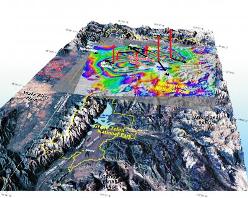
The supervolcano is inflating at record rate, reports Ted Nield
The Yellowstone “supervolcano” rose at a record rate since mid-2004, probably because a Los Angeles-sized, pancake-shaped blob of molten rock was injected 10km beneath the slumbering giant, University of Utah scientists report in the journal Science.
“There is no evidence of an imminent volcanic eruption or hydrothermal explosion. That’s the bottom line” says seismologist Robert B Smith, lead author of the study and professor of geophysics at the University of Utah. “A lot of calderas worldwide go up and down over decades without erupting.”
The upward movement of the Yellowstone caldera floor – almost 7 centimetres per year for the past three years – is more than three times greater than ever observed since such measurements began in 1923, says the study in the Nov. 9 issue of Science by Smith, geophysics postdoctoral associate Wu-Lung Chang and colleagues.
“Our best evidence is that the crustal magma chamber is filling with molten rock,” Smith says. “But we have no idea how long this process goes on before there either is an eruption or the inflow of molten rock stops and the caldera deflates again,” he adds.
Yellowstone is North America’s largest volcanic field, produced by a “hotspot” – a gigantic plume of hot and molten rock – that begins at least 650km beneath Earth’s surface and rises to 50km underground, where it widens to about 480km across. There, blobs of magma or molten rock occasionally break off from the top of the plume, and rise farther, resupplying the magma chamber beneath the Yellowstone caldera.
Previous research indicates the magma chamber begins about 8km beneath Yellowstone and extends down to a depth of at least 16km. Its heat powers Yellowstone’s geysers and hot springs – the world’s largest hydrothermal field.